Student Housing Becoming Increasingly Luxurious and Popular Among Investors
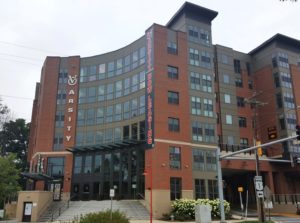 The Varsity Student Apartments in College Park, MD
The Varsity Student Apartments in College Park, MD
Steadily Increasing Enrollment Driving Student Housing Shortage Nationwide
More and more students are pursuing post-secondary education in the United States. National undergraduate enrollment for 2016 was estimated to be 17.49 million—16% higher than 2006, and 81% higher than 1980. Although the 2016 figure is below the 2010 record of 18.08 million, undergraduate enrollment in the U.S. is projected to steadily increase to 19.76 million by the 2025-2026 school year.
Of course, all of these students need a place to stay while attending college. Not surprisingly, most colleges and universities around the country have struggled to cope with this enduring surge in enrollment, and have been unable to provide on-campus dwellings for many upper- and lower-classmen.
This trend is readily apparent in the Washington area, where the University of Maryland, College Park (UMD) has had a shortage of on-campus housing dating back to 1994. There are currently a total of 9,518 beds in residence halls on the UMD campus to serve a projected 25,600 undergraduates during the 2016-2017 academic year. Due to this extremely limited supply, only freshman and sophomore students are guaranteed on-campus housing, while other students are placed on a waiting list.
As a result, thousands of students at UMD and many other colleges and universities across the nation, are forced to seek housing off-campus, preferably in close proximity to campus. The resultant heavy demand for off-campus student housing demand provides a healthy market for developers nationwide to construct multifamily buildings tailored specifically for college students.
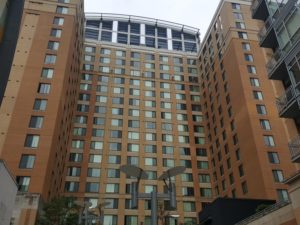 The Towers at University Town Center student apartments in Hyattsville, MD
The Towers at University Town Center student apartments in Hyattsville, MD
Student Housing Market is Increasingly Amenity-Driven
Perhaps the most notable trend for student housing products in recent years is the escalating level of luxury. As developers compete with each other for off-campus students, they are offering more and higher-quality amenities. Seemingly every comfort- and convenience-enhancing feature imaginable has been incorporated into modern student apartment projects, which now resemble high-end resorts more than traditional college dorms.
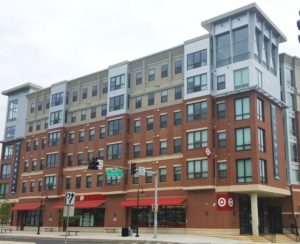 Landmark College Park has 5 stories of student apartments above a new TargetExpress convenience store on the ground floor
Landmark College Park has 5 stories of student apartments above a new TargetExpress convenience store on the ground floor
Amenities once unheard of in the marketplace, such as plank flooring, walk-in closets, fitness centers with yoga/spin studios, clubrooms with shuffleboard and billiards tables, and movie theaters, have become ubiquitous among the newest properties. At the very top end of the market, tanning rooms, infinity pools, golf simulators, and spas offering manicures, pedicures, and massages can be found. Other, more traditional amenities, such as study rooms and businesses centers, are pretty much essential for student apartment properties to effectively compete.
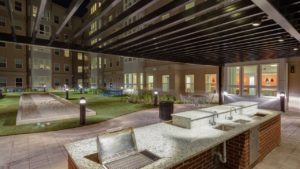 The interior courtyard at Landmark College Park features a bocce ball court and grilling stations
The interior courtyard at Landmark College Park features a bocce ball court and grilling stations
Photo credit: Entrata, Inc.
In College Park, MD nine new student apartment buildings –including one restricted to graduate students—with 7,079 beds have been constructed in since 2009, each project offering more high-end amenities than the previous one. From Zipcars, to bike storage/repair rooms, to saunas, to volleyball courts, the plethora of amenities is enough to make new Terps feel more like they are on vacation than at school. The only amenity conspicuously absent among many of the newest properties is a swimming pool, thanks to temperate Mid-Atlantic climate that allows for just a few weeks of warm weather during the school year. Aside the lack of swimming pools, and the considerable reduction in living area per tenant, new student apartments in the College Park-Hyattsville submarket are virtually indistinguishable from their conventional, Class A apartment peers, inside and out.
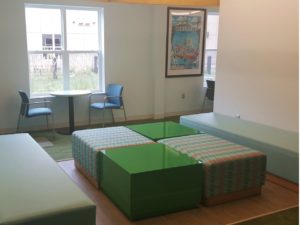
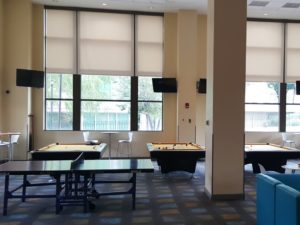 Club/game room at Landmark College Park (left) and study lounge at The Towers at University Town Center (right)
Club/game room at Landmark College Park (left) and study lounge at The Towers at University Town Center (right)
Student Housing Is Becoming More Popular Among CRE Investors
Once a niche multifamily sector, student housing has been steadily increasing in popularity as a source of solid CRE investment opportunities. Thanks to ever-increasing enrollment, demand for student housing is sustained and consistent. During economic downturns, including the recent Great Recession, demand for student housing actually increases as reduced employment opportunities encourages young adults to expand or enhance their education. Most student housing submarkets have very high rates of occupancy compared to their conventional apartment equivalents. For instance, in the College Park-Hyattsville submarket in Prince George’s County, Maryland, student housing occupancy as of September 2016 stood at 97%, while occupancy for conventional Class A apartments in the geographically similar Northern Prince George’s submarket stood at 87.5%.
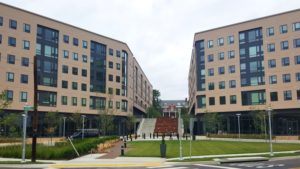 The 1,493-bed student apartment and townhome Terrapin Row complex in College Park began move-ins in August 2016 90.5% preleased
The 1,493-bed student apartment and townhome Terrapin Row complex in College Park began move-ins in August 2016 90.5% preleased
Student housing properties are especially lucrative because of their efficiency in accommodating more tenants/SF than any other type of residential development. For newer properties in College Park, effective rent is often well in excess of $2.50/SF. Tenants also present less default risk than conventional apartment tenants, thanks to financial backing and guarantees from parents (who often have high incomes and are college-educated themselves). Resultantly, foreign, private, REIT, and institutional investors have been flocking to the student-housing capital market. Student housing trading volume more than doubled from $2.5 billion in 2005 to $$5.8 billion in 2015, accounting for a steadily rising share of overall multifamily property sales.
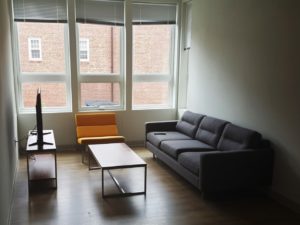 Living area of a unit at Landmark College Park
Living area of a unit at Landmark College Park

